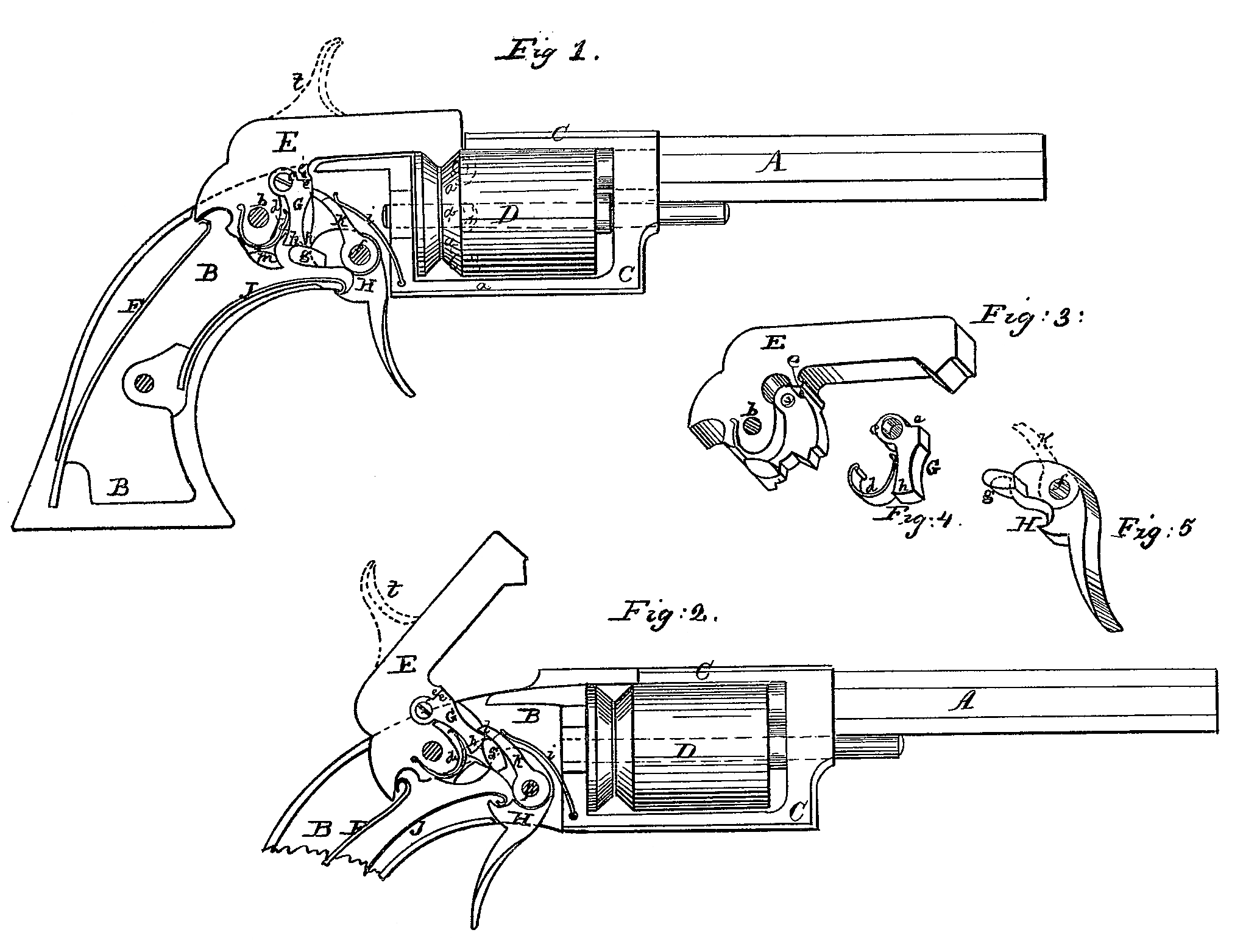USA 16575
UNITED STATES PATENT OFFICE.
FRANCIS S. BRETTELL AND JOS. B. FRISBIE, OF ALLEGEIENY CITY, PA.
IMPROVEMENT IN FIRE-ARMS.
Specification forming part of Letters Patent No. 16,575, dated February 10, 1857.
To all whom it may concern:
Be it known that we, Francis S. Brettell and Joseph. B. Frisbie, both of Allegheny City, in the county of Allegheny and State of Pennsylvania, have invented a new and useful Improvement in Self-Cocking Fire-Arms; and we hereby declare that the following is a full, clear, and exact description of the construction and operation of the same, reference being had to the accompanying drawings, forming a part of this specification, in which—
Figure 1 represents a view of a pistol, (the side plate of the lock being removed in order to exhibit the interior parts of the lock,) the parts of the lock in this figure being represented in the position when the hammer is down. Fig. 2 is a view of the lock when the hammer is at full-cock. Fig. 3 is a perspective view of the hammer. Fig. 4 is a perspective view of a hinged arm, H, between the hammer and the trigger; and Fig. 5, a perspective view of the trigger.
The nature of our invention consists in the arrangement of a pawl or catch, and of a notch and a claw at the hammer operating together and with the trigger in such a manner that the hammer can be kept at full-cock and that the trigger at the same time is prevented from flying back as long as the hammer is kept at full-cock. The hammer being in this position can be fired off by a slight touch on the trigger.
To show our invention more fully, we proceed to describe the parts of the same, taking reference to the annexed drawings, in which the same letters of reference indicate like parts.
The drawings represent our arrangement as applied to a revolving pistol.
A is the barrel; B, the handle, which is cast in one piece with the cylinder-frame C. D represents the cylinder, the cones a for the caps being indicated on it by dotted lines in Fig. 1. E is the hammer; b, its pin. F is the mainspring operating on the hammer; G, an arm connected to the hammer by a butt-hinge joint c c; d d, a spring fastened to the hammer and operating against the hinge-arm G, keeping the arm in a forward position as far as allowed by the butting faces e e’ of the joint. H is the trigger; f, its pin; g g, a cam or projection on the trigger acting on the heel h of the hinged arm when the trigger is pulled. J is the trigger-spring. K is a pawl or catch set on the trigger-pin f; i i, a spring operating on the pawl. There is a notch, l, provided on the hammer, into which the pawl will drop (by the action of the spring i) when the hammer is in raised position.
m is a claw, made with the hammer in one piece, by which the trigger is prevented from going back when the hammer is set at full-cock.
The operation of the parts as described is as follows: When the trigger is pulled the cam g operates on the heel of the hinged arm G and forces the same up, whereby the hammer is raised until it has acquired the position as shown in Fig. 2, when the hammer is at full-cock. At this moment the notch l of the hammer has arrived at the upper end of the pawl K, and the same will drop into it, keeping thereby the hammer in cocked position. The trigger is also prevented from flying back by the claw in of the hammer, which sets close against the cam g of the trigger. Thus the hammer and trigger are secured in their respective positions when at full-cock. By giving now the trigger a slight additional movement the cam g of the trigger leaves the heel h of the arm G, and throws at the same time the pawl K out of the notch l, whereby the hammer is set free and the pistol or other fire-arm is discharged. By this arrangement the fire-arm can be fired off with a greater accuracy than could be done without keeping the hammer at full-cock. The arrangement of the pawl or catch K enables to cock the hammer by means of thumb-piece on the hammer in such cases where this may be preferred, the thumb-piece being indicated by dotted lines at t in Figs. 1 and 2. Thus the cocking can be done either by pulling the trigger or the hammer directly.
In the figures no parts for the purpose of operating the cylinder are shown, as this has no relation to our improvement and may be done in any known manner.
We wish it understood that we do not confine our improvement to be used in revolving fire-arms only, but the same may be used in any other class of fire-arms also.
What we claim as new, and desire to secure by Letters Patent, is—
The arrangement of the pawl or catch K, notch l, and claw an on the hammer, and the cam g on the trigger, or any other arrangement substantially the same, for the purpose of keeping the hammer and the trigger in their respective positions when at full-cock, as herein set forth.
Francis S. Brettell.
Joseph. B. Frisbe.
Witnesses:
Samuel W. White,
Alexander Hays.

